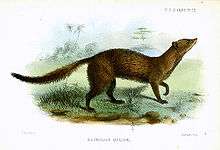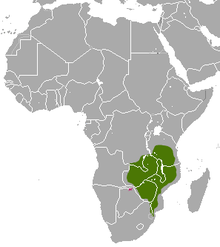Meller's mongoose
Meller's mongoose (Rhynchogale melleri) is a species of mongoose found in Africa. It occurs in Democratic Republic of the Congo, Malawi, Mozambique, South Africa, Swaziland, Tanzania, Zambia and Zimbabwe. It is the only member of the genus Rhynchogale.[2]
| Meller's mongoose | |
|---|---|
 | |
| Scientific classification | |
| Kingdom: | Animalia |
| Phylum: | Chordata |
| Class: | Mammalia |
| Order: | Carnivora |
| Suborder: | Feliformia |
| Family: | Herpestidae |
| Genus: | Rhynchogale Thomas, 1894 |
| Species: | R. melleri |
| Binomial name | |
| Rhynchogale melleri Gray, 1865 | |
 | |
| Meller's mongoose range (green - extant, pink - probably extant) | |
Description
Meller's mongoose is a medium to large-size mongoose with a light to dark brown body and a long tail. At close quarters the upper parts of Meller's mongoose are coarsely grizzled. The lower parts of the limbs are darker than the upper parts of the body. The under parts are generally lighter in colour than the upper parts. It measures about 80 cm in length overall and weighs 2–3 kg. The tail is slightly less than half the overall length.[3] The tail is variable in colour and may be black, brown or white, although dark brown to black is the most usual. Meller's mongoose may be confused with the white-tailed mongoose, however it is smaller and blacker overall than this species.[4]
Distribution and habitat
Meller's Mongoose ranges from central Tanzania south through Malawi, Zambia, Zimbabwe and Mozambique, to Swaziland and northeastern South Africa.[1] It has been recorded to 1,850m asl in Tanzania.[5]
Meller's mongoose is a savanna species, mainly associated with open woodland and grassland and marshy areas with termitaria.[6] It lives in miombo (Brachystegia) woodlands in Zambia,[7] Zimbabwe and Malawi[8] and montane bamboo forests in Tanzania.[5] It appears to require dense cover throughout the year and is rarely seen in areas where fires are extensive and frequent.[9]
Behaviour and ecology
Meller's mongoose is nocturnal, solitary and terrestrial. They do not appear until well after sunset and continue to be active until about midnight.[8]
Diet
Meller's mongoose feeds mainly on termites, particularly harvester termites (Hodotermes) and the larger Macrotermes. They also eat grasshoppers, small reptiles, centipedes, beetles and frogs.[8]
Reproduction
They appear to breed at the beginning of the wet season (November to December). 2-3 young are born in burrows or rock crevices. Females have two pairs of abdominal mammae.[8]
Threats
There are no major known threats to the species. Its favoured habitat is extensive, and in some parts overlaps with very low human populations.[1] However, human expansion and domestic dogs could represent a significant threat in localised areas.[6] However, in parts of northern South Africa the species has been recorded in areas with high human and domestic dog disturbances.[4]
Status and abundance
Listed as Least Concern by IUCN, it is apparently uncommon to rare, but it may be easily overlooked or confused with other mongoose species.[1]
References
- White, P.A.; Mateke, C.W.; Bird, T.L.F.; Swanepoel, L.H. & Do Linh San, E. (2015). "Rhynchogale melleri". IUCN Red List of Threatened Species. 2015: e.T41623A45209275.
- Wilson, D.E.; Reeder, D.M., eds. (2005). "Rhynchogale". Mammal Species of the World: A Taxonomic and Geographic Reference (3rd ed.). Johns Hopkins University Press. ISBN 978-0-8018-8221-0. OCLC 62265494.
- Skinner, J.D.; Smithers, R.H.N. (1990). The Mammals of the Southern African Subregion. Transvaal: University of Pretoria.
- Stuart, C.; Stuart, T. (2007). Field Guide to Mammals of Southern Africa. Cape Town: Struik.
- De Luca, D.W.; Mpunga, N.E. (2005). "Carnivores of the Udzungwa Mountains: Presence, distributions and threats". Small Carnivore Conservation. 32: 1–7.
- Stuart, C.; Stuart, T. (2013). "Rhynchogale melleri Meller's Mongoose". In Kingdon, J.; Hoffmann, M. (eds.). The Mammals of Africa. Volume V: Carnivores, Pangolins, Equids and Rhinoceroses. London: Bloomsbury Publishing.
- White, P.A. (2013). "Distribution, habitat use and activity patterns of nocturnal small carnivores in the North Luangwa Valley, Zambia". Small Carnivore Conservation. 48: 37–46.
- Skinner, J.D.; Chimimba, C.T., eds. (2005). The Mammals of the Southern African Subregion. Cambridge: Cambridge University Press.
- Kingdon, J. (2003). The Kingdon Field Guide to African Mammals. London: A & C Black.
| Wikispecies has information related to Rhynchogale |
